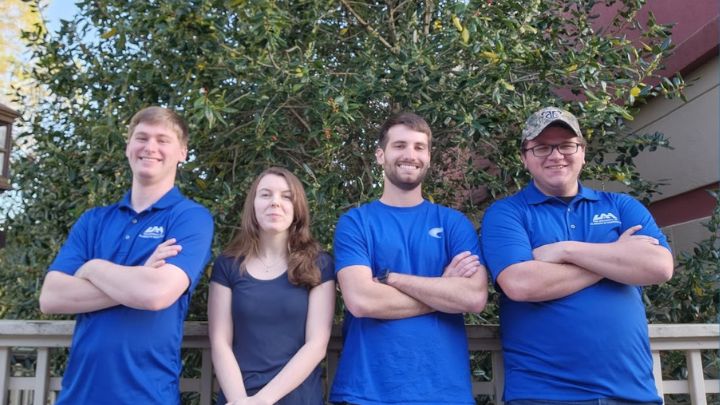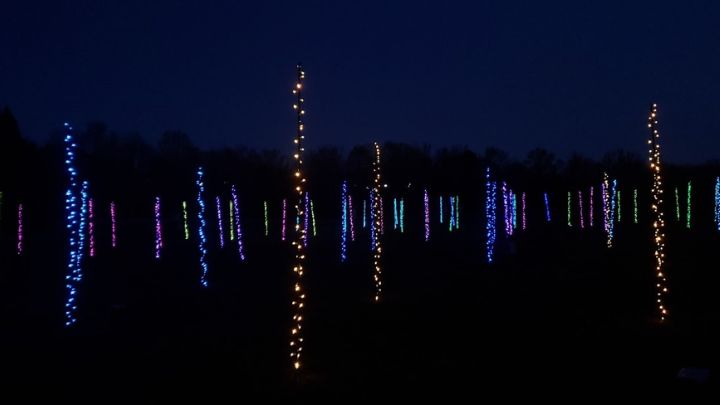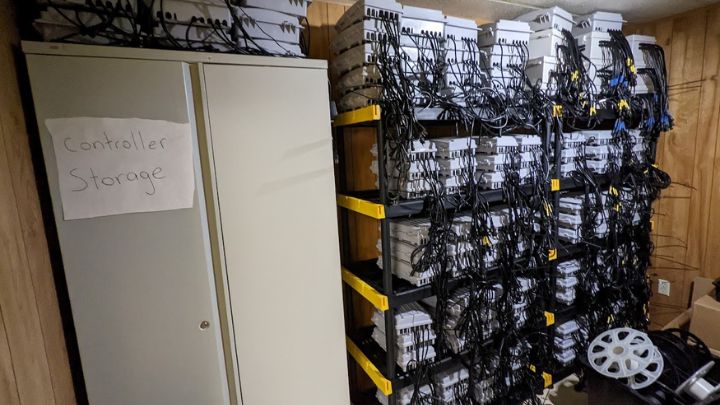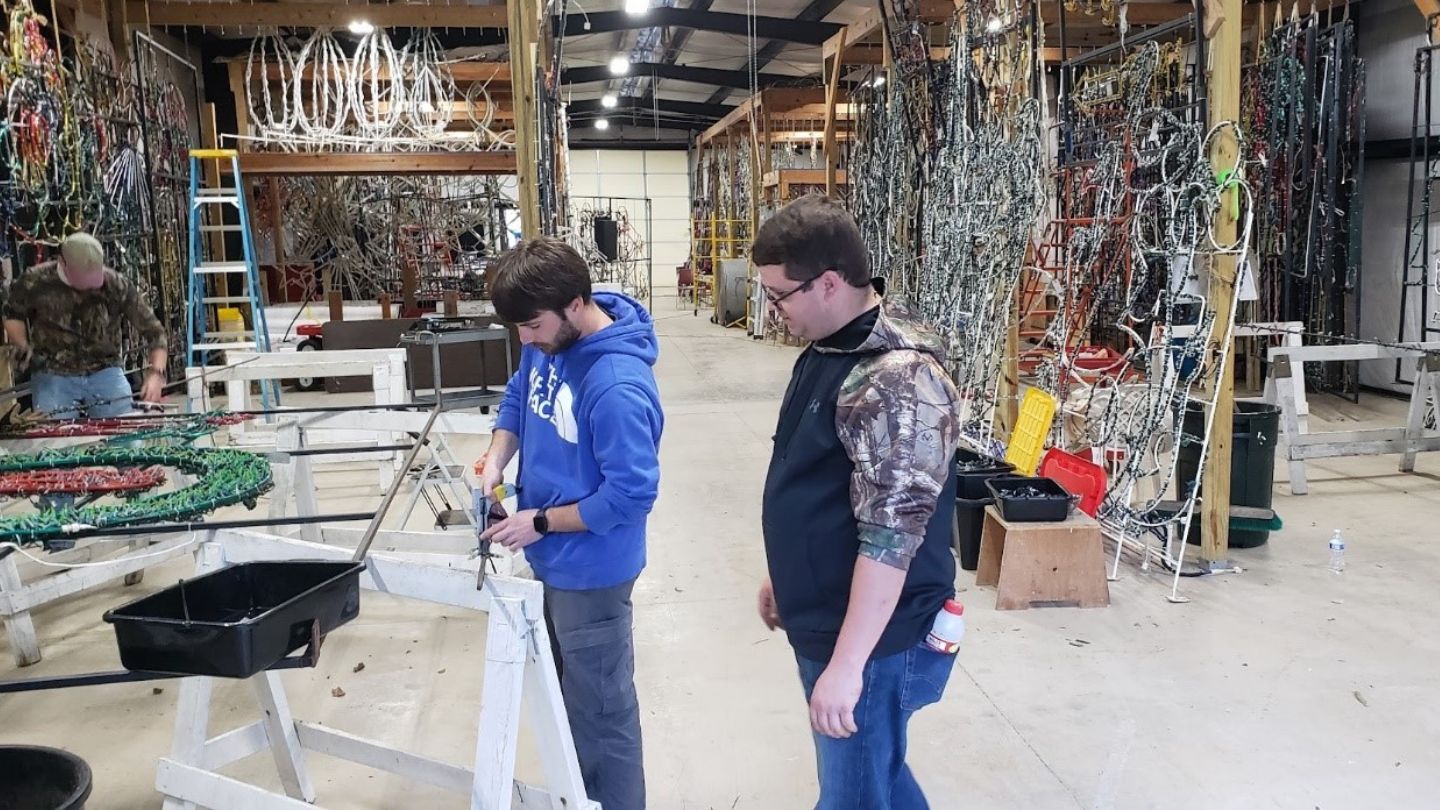A student team from The University of Alabama in Huntsville (UAH), a part of The University of Alabama System, recently designed and deployed an interactive light show for visitors to the Huntsville Botanical Garden (HBG). The installation was completed as part of a senior design project.

Electrical engineering student design team (L-R) Steven Byrd, Savannah Flaherty, Tristan McCarver, Trey Thompson.
Courtesy Steven Byrd
The Light Show Design project was created by four UAH engineering students, including Team Lead Steven Byrd, Software Co-Leads Savannah Flaherty and Trey Thompson, as well as Hardware Lead Tristan McCarver. The project came about through a connection Byrd had through his position as the Lighting Design and Programming Manager at the Huntsville Botanical Garden.
“Steven Byrd, the Chargin’ RGBs Design Project Team Lead, currently works and was working in the position of Lighting Design and Programming Lead at the beginning of the semester,” explains Dennis Hite, a senior lecturer in the UAH department of electrical and computer engineering. “Within this position, Steven supports all projects related to light shows at the Garden, including new technology additions to Galaxy of Lights.

Interactive display ready for visitors at the HGB.
Courtesy Steven Byrd
“With the support of Garden leadership, the addition of newer light technologies to Galaxy of Lights in 2021 paved the way for technology to be worked on and invested in for the Senior Design Project,” Hite says. “Tristan McCarver, the Hardware Lead helped with hardware selections that facilitated a truly interactive light show, while Savannah Flaherty and Trey Thompson, Software Co-Leads, supported software development and testing.”
The design that powers the project consists of passive infrared sensors linked with a Raspberry Pi which served as the brains of the system.
“The design concept uses eight passive infrared (PIR) sensors,” Hite says. “These sensors sense a thermal signature and measures this heat in the infrared region of the optical spectrum. A person walking by will trigger the sensor, making these PIR sensors very useful for an interactive light show display. When an object is within the range and field of view of the sensor, the voltage goes ‘high,’ and when the object passes the sensor, the voltage goes ‘low.’ In a high voltage state, the light show turns ‘on,’ and in a low voltage state, the light show turns ‘off.’”
The PIR sensors have a range of 20 feet and require 5 to 12 volts of DC current to operate.
“The team is using a 5V power supply to power the eight sensors,” Hite notes. “The power supply is located inside a bub’s box that also houses the Raspberry Pi. They are using cat5 to send power and data to the sensors and a Raspberry Pi which runs software called Falcon Pi Play (FPP) which sets the sensors to trigger when a person steps into the detectable region of the infrared sensor. This will, in turn, trigger the Raspberry Pi, which will then send a command to a F48 Falcon controller.”

Controllers used, storage area.
Courtesy Steven Byrd
Raspberry Pi is an inexpensive single-board computer that supports Linux®, an open-source operating system, while also providing a set of GPIO (general purpose input/output) pins which allow the user to control electronic components for physical computing and to explore the Internet of Things (IoT). The Internet of things describes physical objects with sensors, processing ability, software and other technologies that connect and exchange data with other devices and systems over the net.
“The F48 Falcon controller sends messages to differential receivers, which distribute data to the sensors that instruct them to perform specific functions,” Hite says. “These functions include ‘turn on’ and ‘turn off’ commands that create the light show experience, which incorporates 100-pixel lights wrapped around 10-foot rebar poles.”

10-foot rebar for light poles.
Courtesy Steven Byrd
The students arranged the rebar poles in a grid pattern with the light show commands programmed to be different and specific to each of the eight sensors.
“From the perspective of engineering, the project was undertaken to enhance engineering skills by using what was learned within classes at UAH, as well as new skills learned, on a real-world application,” Hite says. “Accomplishing a project for a class grade and accomplishing a project to be used in the real world are two entirely different battles, and each come with their own set of challenges.”
All work was performed as part of an Electrical Engineering Senior Design team project during their senior design course, EE494. The team’s hard work added up to a stunning visual, as well as aural, experience, which can be seen here from video footage taken at the Garden.

Courtesy Steven Byrd
“This project not only challenged our engineering skills, but it also taught us team skills only learned within the real world,” Hite says. “These skills involved budget building, schedule planning and problem solving for a large-scale project, time management and working for customers who invest money into the project.”